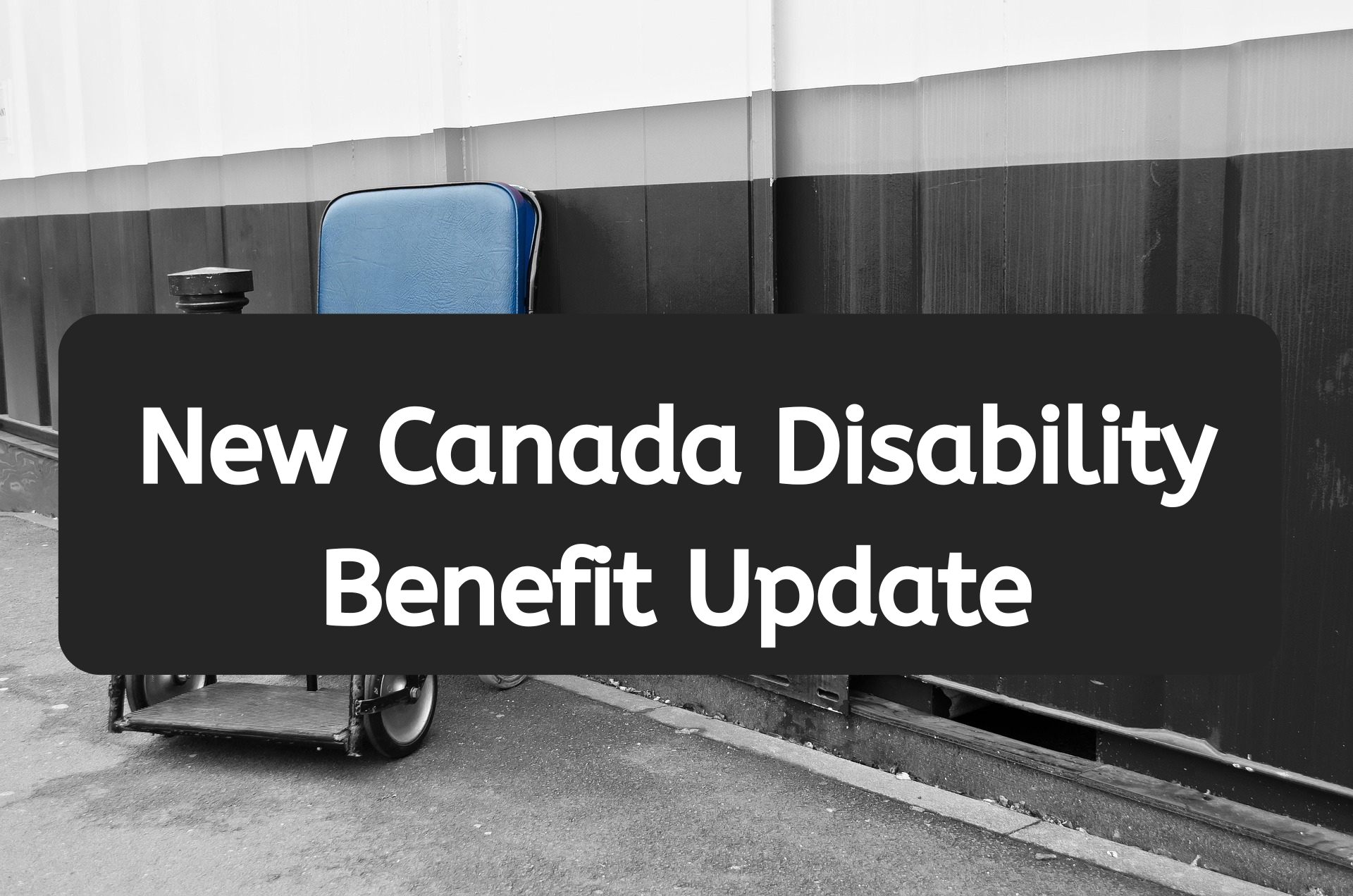New Canada Disability Benefit Update

Canada’s disability support system is getting an important update, and it could affect thousands of Canadians living with disabilities. Whether you already receive the Canada Disability Benefit (CDB) or are considering applying for the first time, staying informed is crucial especially with recent changes that could mean more financial support and simplified application rules.
So, why should you read this guide?
- Stay Ahead of the Changes: The government has updated eligibility rules, payment amounts, and application procedures. Knowing the details now can save you time and frustration later.
- Maximize Your Benefits: Many Canadians may qualify for higher payments or additional support under the new system. This guide will help you understand exactly what you could be entitled to.
- Avoid Common Mistakes: Applying for disability benefits can be complex. The new rules can be confusing, but we break everything down into clear, actionable steps.
- Plan Your Finances Better: With a clear understanding of the updated benefits, you can make informed decisions about budgeting, healthcare costs, and other financial priorities.
By the end of this article, you’ll have a clear understanding of who qualifies, how to apply, and how these updates could impact your financial situation. Think of it as your go-to guide for navigating the new Canada Disability Benefit—without the confusing government jargon.
Key Changes in the New Canada Disability Benefit
The Canada Disability Benefit (CDB) recently underwent major updates, and these changes are designed to make it more accessible and meaningful for Canadians living with disabilities. Here’s what’s new:
Increased Monthly Payments
One of the most significant changes is the boost in monthly payments. The government has recognized the rising cost of living and adjusted the CDB to provide more financial support. Depending on your income, monthly benefits could increase by several hundred dollars, giving many families and individuals more breathing room.
Eligibility Expansion
Previously, some Canadians were excluded from the CDB due to narrow income or disability definitions. The new rules expand eligibility to include more individuals with varying degrees of disability, including those with episodic or fluctuating conditions. This is a huge win for Canadians who struggled to qualify in the past.
Changes to Income Thresholds
The updated CDB now accounts for higher income limits, allowing more Canadians to receive partial benefits. This means that even if you have some employment income or other support, you might still qualify for a portion of the benefit something that wasn’t possible before.
Updated Application Process
The government has simplified the application process to reduce paperwork and processing time. Online applications are now easier to navigate, and the documentation requirements have been clarified. You’ll also notice that response times from the Canada Revenue Agency (CRA) are expected to improve.
Who Qualifies for the New Benefits
Understanding eligibility is crucial to making sure you get the support you’re entitled to. Under the new Canada Disability Benefit rules, here’s who qualifies:
Age and Residency Requirements
You must be a Canadian resident for tax purposes and generally at least 18 years old. Permanent residents and long-term residents may also qualify, depending on their status and contributions to the Canadian tax system.
Disability Criteria
The CDB is designed for Canadians who have a “prolonged and severe” disability, which prevents them from fully participating in daily activities or working at full capacity. Importantly, the new rules recognize a broader range of conditions, including mental health issues, chronic pain, and episodic disabilities.
Families and Caregivers
If you are a primary caregiver for someone with a disability, you may also qualify for additional support. Some provinces offer supplemental benefits that complement the federal CDB, meaning families can receive more assistance than ever before.
Medical Documentation
Proof of disability is still required, but the updated benefit guidelines make it clearer which medical documents are acceptable. A doctor, nurse practitioner, or other qualified health professional can provide certification for your application.
How to Apply for the Updated Canada Disability Benefit
Applying for the updated CDB is straightforward if you know the steps. Here’s a step-by-step guide:
Step 1: Check Eligibility
Before you start, make sure you meet the residency, age, and disability requirements. Review the CRA guidelines carefully to see if your medical condition qualifies.
Step 2: Gather Your Documents
You’ll need personal identification, proof of residency, and medical documentation. The new application forms provide a checklist to make this easier.
Step 3: Submit Your Application
You can apply online via the CRA’s secure portal or by mail. Online applications are faster and allow you to track the progress of your submission.
Step 4: Wait for Assessment
After submission, the CRA will review your documents and may contact your healthcare provider for verification. The processing time varies, but the new updates aim to reduce delays.
Step 5: Receive Your Benefit
Once approved, monthly payments are deposited directly into your bank account. Remember to report any income changes, as this can affect the amount you receive.
Tips to Avoid Delays
- Double-check that all documents are complete and legible.
- Make sure your medical forms are signed and dated correctly.
- Keep copies of everything you submit.
Impact on Other Government Benefits
The new Canada Disability Benefit (CDB) doesn’t exist in isolation—it interacts with other federal and provincial benefits, so understanding these connections is key.
Canada Pension Plan Disability (CPP-D):
Many Canadians receiving CPP Disability may also qualify for the new CDB. However, payments can sometimes be coordinated, meaning your total combined income could affect eligibility or benefit amounts. For example, higher CPP-D income might slightly reduce your CDB payment, but you will still likely see a meaningful boost in overall support.
Employment Insurance (EI) & Old Age Security (OAS):
Receiving CDB typically does not impact EI benefits if you’re still eligible to work or are on EI sickness benefits. Similarly, OAS payments are generally unaffected, but it’s always wise to report your new income to the CRA to avoid future reconciliation issues.
Provincial and Territorial Benefits:
Some provinces, like Ontario and British Columbia, offer top-ups or complementary disability supports. With the new CDB, your provincial disability support may adjust, so checking with your local ministry or service centre is essential to ensure you don’t miss out.
In short: the new CDB is designed to enhance your financial security without undermining other supports—but staying informed and proactive is crucial.
Frequently Asked Questions (FAQs)
Here are the questions Canadians most often ask about the new CDB:
Q1: Can I apply if I was previously denied?
Yes! The updated eligibility rules may allow individuals previously denied to qualify now. Review your medical documentation carefully and consider reapplying if your situation aligns with the new criteria.
Q2: How quickly will I receive payments after approval?
Processing times vary, but the government aims to issue the first payment within 4–6 weeks of approval. Delays can happen if documentation is incomplete, so double-check all forms before submitting.
Q3: Can I continue working and still get the benefit?
Absolutely. The CDB is designed to support Canadians with disabilities who are working, studying, or participating in their communities. You may need to report changes in your income, but your benefit will adjust without cutting you off completely.
Q4: What documents are required for proof of disability?
Typically, a medical professional’s certification detailing your condition, its impact on daily life, and any treatment plans is required. Ensure your documents are up-to-date and clearly describe how your disability affects your ability to work or perform daily activities.
Q5: Are there tax implications?
The CDB is non-taxable, meaning you won’t have to pay income tax on the payments. This makes it easier to plan monthly budgets without worrying about tax deductions.
7. Tips for Maximizing Your Benefit
Here’s how Canadians can get the most out of the new CDB:
- Apply Early:
Even if your condition is recent, don’t wait. Submitting your application promptly ensures you can receive payments sooner. - Keep Documentation Updated:
Medical records, income statements, and any relevant assessments should be current. Outdated information can delay approvals. - Report Changes Promptly:
Any change in income, address, or medical status should be reported to avoid payment interruptions or overpayment adjustments. - Leverage Provincial Supports:
Check whether your province offers top-ups or complementary disability programs. The CDB often pairs well with these, boosting overall support. - Seek Professional Help if Needed:
Disability advocates or financial consultants specializing in Canadian benefits can help ensure your application is complete and accurate, reducing the risk of delays or denials. - Stay Informed About Future Updates:
The government may adjust the CDB for inflation or eligibility. Signing up for official newsletters or following government announcements ensures you never miss an update.
Pro Tip: Many Canadians are surprised to learn that the combination of CDB, CPP-D, and provincial supports can provide a much stronger safety net than any single benefit alone—planning carefully can maximize your monthly income.



